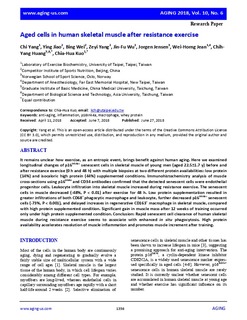| dc.contributor.author | Yang, Chi | |
| dc.contributor.author | Jiao, Ying | |
| dc.contributor.author | Wei, Bing | |
| dc.contributor.author | Yang, Zeyi | |
| dc.contributor.author | Wu, Jin-Fu | |
| dc.contributor.author | Jensen, Jørgen | |
| dc.contributor.author | Jean, Wei-Horng | |
| dc.contributor.author | Huang, Chih-Yang | |
| dc.contributor.author | Kuo, Chia-Hua | |
| dc.date.accessioned | 2019-05-08T11:06:09Z | |
| dc.date.available | 2019-05-08T11:06:09Z | |
| dc.date.created | 2018-10-08T13:36:34Z | |
| dc.date.issued | 2018 | |
| dc.identifier.citation | Aging. 2018, 10, 1356-1365. | nb_NO |
| dc.identifier.issn | 1945-4589 | |
| dc.identifier.uri | http://hdl.handle.net/11250/2596975 | |
| dc.description | This is an open‐access article distributed under the terms of the Creative Commons Attribution License (CC BY 3.0), which permits unrestricted use, distribution, and reproduction in any medium, provided the original author and source are credited | nb_NO |
| dc.description.abstract | It remains unclear how exercise, as an entropic event, brings benefit against human aging. Here we examined longitudinal changes of p16Ink4a+ senescent cells in skeletal muscle of young men (aged 22.5±1.7 y) before and after resistance exercise (0 h and 48 h) with multiple biopsies at two different protein availabilities: low protein (14%) and isocaloric high protein (44%) supplemented conditions. Immunohistochemistry analysis of muscle cross‐sections using p16Ink4a and CD34 antibodies confirmed that the detected senescent cells were endothelial progenitor cells. Leukocyte infiltration into skeletal muscle increased during resistance exercise. The senescent cells in muscle decreased (‐48%, P < 0.01) after exercise for 48 h. Low protein supplementation resulted in greater infiltrations of both CD68+ phagocytic macrophage and leukocyte, further decreased p16Ink4a+ senescent cells (‐73%, P < 0.001), and delayed increases in regenerative CD163+ macrophage in skeletal muscle, compared with high protein supplemented condition. Significant gain in muscle mass after 12 weeks of training occurred only under high protein supplemented condition. Conclusion: Rapid senescent cell clearance of human skeletal muscle during resistance exercise seems to associate with enhanced in situ phagocytosis. High protein availability accelerates resolution of muscle inflammation and promotes muscle increment after training. | nb_NO |
| dc.language.iso | eng | nb_NO |
| dc.subject | anti-aging | nb_NO |
| dc.subject | inflammation | nb_NO |
| dc.subject | macrophage | nb_NO |
| dc.subject | whey protein | nb_NO |
| dc.subject | p16INK4a | nb_NO |
| dc.title | Aged cells in human skeletal muscle after resistance exercise | nb_NO |
| dc.type | Journal article | nb_NO |
| dc.type | Peer reviewed | nb_NO |
| dc.description.version | publishedVersion | nb_NO |
| dc.rights.holder | © Yang et al. | nb_NO |
| dc.source.pagenumber | 1356-1365 | nb_NO |
| dc.source.volume | 10 | nb_NO |
| dc.source.journal | Aging | nb_NO |
| dc.source.issue | 6 | nb_NO |
| dc.identifier.doi | 10.18632/aging.101472 | |
| dc.identifier.cristin | 1618713 | |
| dc.description.localcode | Seksjon for fysisk prestasjonsevne / Department of Physical Performance | nb_NO |
| cristin.unitcode | 150,31,0,0 | |
| cristin.unitname | Seksjon for fysisk prestasjonsevne | |
| cristin.ispublished | true | |
| cristin.fulltext | original | |
| cristin.qualitycode | 1 | |
